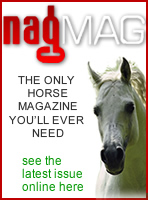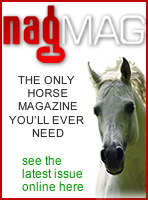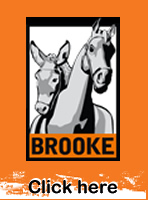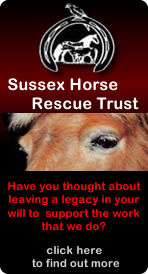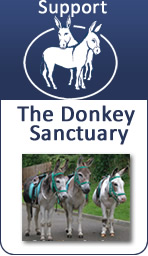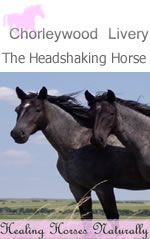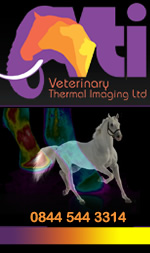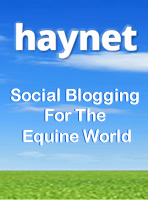
Horseytalk.net Special Interview
Ben Hart
The First World Donkey Symposium
Ben Hart, The Donkey Sanctuary, on 15-years learning about equine behaviour, making a presentation to 120 vets, scientists, donkey charity workers and donkey owners not to mention giving a practical demonstration of his work with donkeys.
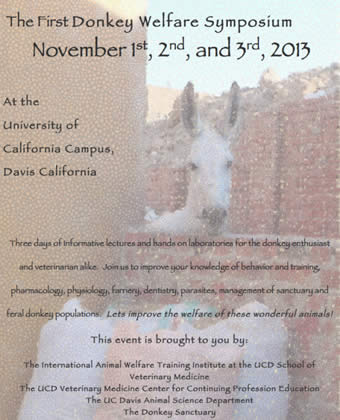 When I started out learning about equine behaviour 15 years ago, I got the chance to spend a year studying, working and eventually teaching in California. That time, working with the world’s best teachers in equine behaviour, the horses themselves, changed my life and my perceptions of equine training methods forever. Those experiences with Mustangs, Arabs, Thoroughbreds, Quarter horses, mares, foals and colts changed me and ultimately set me on a path that led to working with horses, donkeys and mules all over the world.
When I started out learning about equine behaviour 15 years ago, I got the chance to spend a year studying, working and eventually teaching in California. That time, working with the world’s best teachers in equine behaviour, the horses themselves, changed my life and my perceptions of equine training methods forever. Those experiences with Mustangs, Arabs, Thoroughbreds, Quarter horses, mares, foals and colts changed me and ultimately set me on a path that led to working with horses, donkeys and mules all over the world.
So it will be no surprise when I tell you that since then I have always harboured a dream of returning to the States to share what I have been fortunate enough to have learnt since my early stumbling steps learning about equine behaviour. I guess deep down I have always wanted to say thank you to those amazing teachers, the horses, who put up with my learning, accepted my arrogance of thinking I knew something and taught me humility. All my work is dedicated to the horses, donkeys and mules I have learnt from over the years but for those early teachers I always felt it had to be back in America that I needed to say thank you.
This year I have my chance - thanks to donkeys and mules and The Donkey Sanctuary. I was asked to attend and present at the first Donkey Symposium in Davis, California and for about 6 months this conference has been on my mind, not only the presentation to 120 vets, scientists, donkey charity workers and donkey owners, but the practical demonstration of my work with two donkeys.
The question is how do you put 15 years work in a few minutes and hopefully help even more donkeys and mules? It feels as though I have to put my beliefs, my soul, actually myself up on the screen laid bare in the hope of getting more people to think differently about donkeys’ behaviour.
Over these few months people have said most kindly, you will be fine, you will be great, you always are, which is very kind and appreciated, but the truth is this feels different. I so badly want to make a difference to help open a door on donkey behaviour, to help the Sanctuary expand its work and influence to reach more donkeys, but in a country we tend to think of as knowing it all when it comes to behaviour, after all it's where cowboys come from and the horse world is flooded with American trainers visiting the UK to sell their methods, so going the other way seem very daunting.
So over the next few days I am going to tell you about the experience, not just of the presentation, but of the four donkeys, yes, two have become four donkeys that I will have two and half days to work with and what I will learn from them.
The first challenge is actually to get to Davis, California. It sounds glamorous to say I am going to California, and yes I am lucky, but travelling for work is not a holiday, it is about getting where you are going, doing a great job and getting home as soon as possible, to cost the Sanctuary as little money as possible and keep up with all the other things that I have to do. So I left home on Wednesday at 5.30am to drive to the airport and will be back at the airport on Sunday afternoon to fly home again, in time to be back at work Tuesday morning. But for me travelling is a great way to practice the practical application of the science of behaviour and I always learn so much about myself and I am always reminded of the behaviour of equines as I travel.
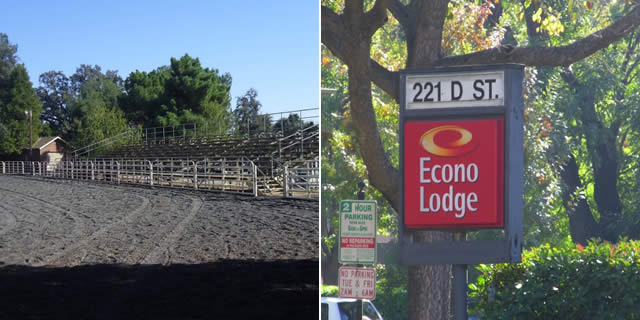
I know I am a behavioural anorak and need to get out more!
First there is the airport and 10 hour flight, time for some behavioural reading and an appreciation of the challenges equines face during their transportation experiences, the need for regular food and water stops, need for rest and leg stretching, the effects of confinement and the disorientation of not knowing where you are going and why, at least I know what is happening and why. Good thing is US customs does let me in, having taken my finger prints, just in case I turn out too dodgy.
Then the comfort zone stretching begins, find your way through an unknown airport to find a rental car. So now just the small matter of navigating through an unfamiliar city, during rush hour. No sat nav, that would be too easy, and it would cost the Sanctuary another $60, so down to a sense of direction, preparation and a map. It is amazing to me how we ourselves choose to or choose not to stretch our comfort zones, yet our donkeys and mules are expected to stretch theirs without question and purely at our discretion. Having a plan and prepared in advance really helps much like a shaping plan for training donkeys, smoothes the journey of training. How do you know how to get there if you don’t know where you are going?
Our brains are amazing, less than 15 hours ago I was driving on the left side of the road and now my brain can switch and allow me to drive on the right. Alright I have had a fair bit of experience of this swapping sides, but it reminds me about our neural path ways and how once we learn a behaviour the potential for it to reoccur is always there, so be careful what you teach. I also think about how to start the journey I am having to concentrate so hard, but as we progress all the old neural pathways are activated and I start to enjoy the view. Much like our donkeys revisiting an old behaviour, we and they too need time to “get in the groove” some more patience at the start of a behaviour always pays extra dividends and creates a better response.
It also makes me think about what it must be like for our donkeys fresh out of the lorry to a new home, we are excited and can’t wait to meet greet and do stuff, yet for me right now it feels like I imagine a donkey would, slightly dazed with sensory overload, disorientated and not sure who to trust. Actually, donkeys need time to settle in, find their feet and we would do better to allow them much more time to settle in. Often owners of donkeys and horses tell me they have been out with their new animal for a walk or a ride the day after they have arrived, that is just way too quick for the animal. They need time to learn how their new two legs behaves and who they can trust, if you get new donkeys take a couple of weeks to quietly let them settle it before you do to much stuff.
I find my way, over the Golden Gate Bridge, just for the experience and right in to a two and half hour traffic jam. Perhaps not what I needed right now, but I can only have one reaction. As those of you who have attended a Stage 5 behaviour training course at the Sanctuary will know, we talk about patience and being in the moment and its importance to good training. We can only control our response to the traffic or the animal’s behaviour, but we cannot control the traffic or the behaviour. To train well we have to learn to stay in the moment because that’s where the animal is, they can not tell we are preoccupied with the future or the past, they think our body language represents what we are feel right now about a situation.
This traffic jam also allows me the chance to explore the random attribution error. This is the principle by which we often mistakenly blame an individual's behaviour on their character rather than on the situation. So I suspect that I may have not driven perfectly during this journey, and another driver may, as we all have at times, thought “what is that jerk doing?” It is highly unlikely someone saw my bad driving and thought “I wonder if he is English, just off a 10 hour flight, not fully used to driving on the wrong side of the road and not quite sure where he is going". We all do it. That person who cuts us up is a fool, at best at worst something unprintable. How often do we think about the bad driver, maybe he has had some terrible news about a family member and he is rushing to the hospital to be by their side, or perhaps he is late for his first job interview after three years of being unemployed, maybe he has just been fired or told he has cancer. Funny though when we drive badly it is not us it is the situation that made us do it. What relevance for equines? Well, all too often, in fact nearly all the time I hear people blame their animal's character, he’s a git, she’s naughty, she’s stroppy, hormonal, mareish or he is dominant. Maybe or maybe not, but it is much more productive to look at the donkey's environment and situation, that is a far greater cause of their behaviour. Look for the situation as a cause, fear, not enough stimulation, incorrect diet, pain, stress, frustration and you can do something about it rather than just blame the animal.
Anyway the good thing about all this traffic and arriving at my hotel at 9pm US time (4am UK) is that I am calm, I have been putting so much pressure on myself about this presentation that I could have missed out on enjoying the experience by not being in the moment, and there is no way you can do your best training with donkeys or humans when you are pressured, and trying to get them to achieve something within time restraints, I cannot control the results only my performance. This trip has fortunately reminded me to relax, enjoy the journey and to lower my expectations, it is not about me it is about what the donkeys can achieve and how we can help them. Thank goodness for the traffic jam I might have missed out on the learning.
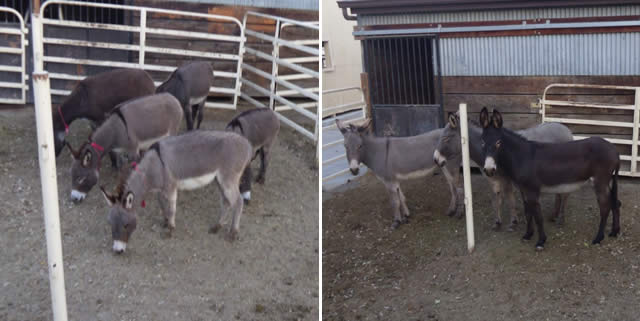
The donkeys for tomorrow arrived, so lovely to see them here. They do have a couple of stallion Jack donkeys which are used for breeding mules here at the University. They were equally excited to see lots of donkeys arrive.
There is a range of donkeys from minis, to larger standard donkeys, even one with the Bureau of Land Management (BLM) freeze brand identifying him as a former free ranging feral donkey removed from federal lands as part of their control measures for wild burros and mustangs. It is a big day for them too. 150 people. Strange environment, so it will be important to only do what they can do and not put pressure on them.
They all have one thing in common, very little handling. In fact in some cases no handling at all. Some of these donkeys are up for adoption so it would be great to make a difference to them over the next couple of days in the hope it might help them find a forever home.
Tomorrow will be a great chance to learn from so many donkeys and donkey people, looking forward to it but also quite fearful too so of for some sleep as have to be at the barn early to help get the donkeys all in the right places before the morning of presentations.
Wish me luck.
So I woke up at 2.30 thinking about today, and it took about an hour to get it all straight in my head, I guess when something really means something to you then it's worth being up nights for. When I was first in California 15 years a ago, the barn manager at Crawford Hall used to say “You are not training horses unless they keep you up nights thinking about them”, and I guess the same goes for donkeys too.
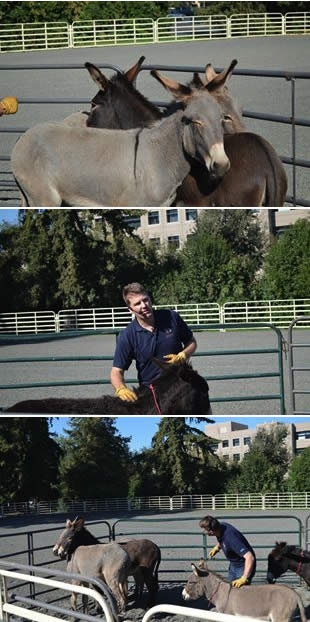 The day started with the usual thanks to everyone for coming and the hard work and the length of time this event had been in the planning and how it got started with our very own Stephen Blakeway involved and key right from the start. And you could feel the excitement of the 150 plus donkey owners, rescue and charity workers and vets in the room and what was immediately apparent was that even most of the vets owned donkeys. As a speaker that made me relax because donkey owners are a breed apart, always enthusiastic, generally cheerful and very, very keen to learn, oh and they love to talk about donkeys.
The day started with the usual thanks to everyone for coming and the hard work and the length of time this event had been in the planning and how it got started with our very own Stephen Blakeway involved and key right from the start. And you could feel the excitement of the 150 plus donkey owners, rescue and charity workers and vets in the room and what was immediately apparent was that even most of the vets owned donkeys. As a speaker that made me relax because donkey owners are a breed apart, always enthusiastic, generally cheerful and very, very keen to learn, oh and they love to talk about donkeys.
Stephen got us off to a great start explaining to the audience the work of the Sanctuary and it was kind of neat (to use the American phase) to be in a crowd of people who really didn’t know too much about the Sanctuary and the wonderful work we do, and see them slowly begin to gasp the sheer size, amazing depth and incredible impact the Sanctuary makes on the lives of donkeys around the world.
A video presentation of the work in the brick kilns of Egypt really brought home the need for more help for donkeys around the world and the amazing work and success of our teams overseas.
Some technical hitches with the webinar part delayed my start, but actually all the preparation just like when training a donkey paid off, and I was just in the moment and enjoying the wonderfully friendly atmosphere created by 150 excited donkey owners. The result was I loved it, everything went to plan we had fun and hopefully I got people thinking about donkey behaviour and its true importance to welfare.
Then on to the practical. It's OK talking and presenting well, but as a trainer, can you walk the talk? So over to the University's horse yards where 130 people were sitting up in the stands and 5 beautiful donkeys standing in the lovely Californian Sun.
Three of the donkeys were unhandled and very nervous and two really very friendly, so always start with the easy ones. Bless them they very quickly showed that they loved a good scratch and were happy to follow me around wanting more, lovely to see them think and figure out how to get more scratches. I worked with the beautiful bay mare who was a little more inquisitive and we were able to demonstrate the use of negative and positive reinforcement, timing, stretching comfort zones.
Did I get them to do anything? No not really, an arena, in the sun, in front of 130 people during a demo is never really the place to do very much at all other than show the potential for understanding donkey behaviour communication and the donkeys are always the best teachers.
To do this you have to trust the people watching get it, that they care enough to understand doing very little and taking little steps is the best thing to it has to be about the donkey no matter what you are doing, and no matter who you are doing it in front of.
I didn’t need to worry, the wonderful audience totally got it, their questions and comments were so incredibly positive and enthusiastic.
Tomorrow, I am going to work with these donkeys all day to see if I can help them a little bit more so more of that tomorrow.
So, with the formal part done I can relax a little and just get to work with the donkeys from yesterday. Beautiful blue sky, sun, 23 degrees, shade of tree, training doesn’t get any more comfortable than this, sorry if you are reading this from a cold wet English November day.
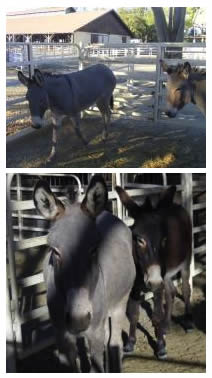 I decide to work with the 3 unhandled donkeys, the dark brown mare, and the two grey mares in the photos. It seems they are most likely to benefit from some pleasant experiences. These donkeys are nervous, very fearful, scared and really have no value in humans, so not much of a starting point. Like all donkeys, these girls are great teachers, they really show the differences between individuals and the importance of listening to their individual needs as you train. Unfortunately it turns out these girls aren’t just unhandled, they have had some unsuccessful attempts at handling, which means that they are going to be harder to work with because they will have learnt how to avoid humans.
I decide to work with the 3 unhandled donkeys, the dark brown mare, and the two grey mares in the photos. It seems they are most likely to benefit from some pleasant experiences. These donkeys are nervous, very fearful, scared and really have no value in humans, so not much of a starting point. Like all donkeys, these girls are great teachers, they really show the differences between individuals and the importance of listening to their individual needs as you train. Unfortunately it turns out these girls aren’t just unhandled, they have had some unsuccessful attempts at handling, which means that they are going to be harder to work with because they will have learnt how to avoid humans.
Environment is crucial to training and sometimes you find you aren’t in an ideal environment. Because these donkeys have so much fear they are going to run for a long time before they even think about considering any contact, so I start working in a smaller space which gives the donkeys less opportunities to run away. However, working in a pen 8ft x 8ft allows these girls some choice to tell me they don’t want to be near me, but means I am constantly in the kick zone. This is dangerous, there is nowhere to go and if you get it wrong it can be serious. Health and safety tip, don’t try this at home.
For me this serious risk means I have to work respectfully, listen to the animal carefully, and stretch the comfort zones below the need for the animal to kick. To work like this you also have to trust the true nature of equines. I am in a very small area, with an animal that could break my leg at least or kill me at worst. But the true nature of equines means that they are only going to be defensive and I am only going to be kicked if I get it wrong. Bottom line is, if I choose to work with an animal that is fearful then it is my fault if I get kicked, and these girls know how to kick.
These girls, none of whom have names, are great educators, they are all so different. The grey mares want me to work from their rump forwards and the brown mare prefers head back. The younger grey mare needs to be with the other older one. In moments of stress, she reaches under the larger mare as if to suckle, not something you see in donkeys other than in mares and foals, and just me being in the pen is stressful for all of them, so perhaps they are mother and foal. If these donkeys were at the Sanctuary in the UK then there would be time and staff to provide the training. Here the sheer numbers of donkeys and the limited resources mean there is not the time for training, so anything I can do to help start the process might just mean they have better chance of adoption.
Talking with people at this conference, it is clear that in the USA the donkey, is for many people, a source of ridicule and fun. In many states they are just considered vermin, and support for sanctuaries and rescue is very hard to come by. It seems that the beach donkeys in the UK create a much better image of the donkey that stays with us Brits for life.
It’s so hard, I want to help these three donkeys even more, but there is only so much you can do in a day and the fact that they are willing to accept me stroking them on the neck, withers, back, and giving them a scratch, it’s just amazing.
It’s such a short time and in only three or four 15 minute sessions they are showing so much improvement, given how fearful they are, it’s a tremendous testament to the donkeys’ stoic nature and their ability to be in the moment and to learn and to change. Sometimes we humans hang on to our fears and phobias for a lifetime, never ever getting over them, donkeys seldom have a choice but when faced with the situation that these three are today, they adapt, they learn, they grow and they accept much more readily than we humans do.
The dark bay and the larger grey donkey even show signs of starting to want human contact. In the early part of the afternoon they start to step towards me during our scratching sessions, just a head turn to start with and then half a step and then a full step towards me to try to encourage more mutual grooming. These are such tiny communications of the donkeys’ thoughts, but those participants of the symposium who are now watching really see it, they understand what a massive step this is for these donkeys. I decided that they have had enough for today, such huge improvements, to do more would be unjust to their kind and willing natures and maybe I have opened a tiny window of opportunity that when they get where they are going they might just give some other two legs a chance to get in and handle them. It is too easy to do too much and push them too far, so always quit early.
I’m then asked to work with a donkey that was living at a sanctuary, who has been bought for the hoof trimming demonstrations that are going on and yet he is only here to be companion to his friends because he has great difficulty picking up his feet. The difference with this donkey is that unfortunately, he is grossly obese, to give you an idea he represents the worst pictures that The Donkey Sanctuary ever shows on the great damage and welfare issues caused by obesity. Add to that a fear of having his feet touched and it is clear that his experience of human handling has taught him humans are to be avoided.
What a fabulous donkey, he’s got all of the methods of avoidance that he has learnt from humans. He pushes a little bit, he barges a little bit, he tries to pull away a bit, he rears a bit, he rears towards me, he leans on me, rears away from me, backs up and yes of course he kicks, those things are all really quite tiny and because I am only stretching his comfort zones a little bit they are very minimal, and when I don’t react, stay calm and quiet, bless him, his behaviour quickly subsides and looks for a new way to get rid of the retched two legs who clearly isn’t listening to his concerns about having his feet picked up.
I hear everything that he is saying, but if I can help him a bit to understand standing still and picking his feet up is actually an easier route to getting rid of annoying two legs and there is nothing to be feared, then maybe we can enhance his life. Instead of having to be caught and sedated every time for the hoof trimmer. He can just be caught, handled and have his feet trimmed like any normal donkey is capable of doing.
I am able to demonstrate to the participants how we can break down the behaviour using a shaping plan, to lots of small, safe lessons at home and because he is such a kind willing donkey I am able to show them what’s possible if you understand the science of behaviour and its practical application. Within 25 minutes of small short lessons, interspersed with me talking to the audience, answering questions, he learns to stand and accept having all four feet picked up. He is not completely convinced that it is a good idea, but I am able to show those small signs that donkeys give that allow everyone to understand this and hopefully take the lessons home to work with their donkeys or the donkeys that they care for in their rescue centres and charities.
As always it is the donkeys that are the true stars, they are the ones that deal with fears and phobias, the ones that have to figure out what we want and they make the best teachers. I could talk all day about behaviour but a 25 minute session watching a donkey overcome years of fears and phobias truly can’t be argued with, and yet again it is the donkey that I am working with that ultimately will hopefully help hundreds of other donkeys because now their owners understand them a little better and have a great deal more respect of the difficulties that the donkeys face.
My work here is nearly done and tomorrow I will tell you what I have learnt and the people I have met and what a tremendous few days this has been for The Donkey Sanctuary.
So the three donkeys and their friends that I worked with yesterday have now been loaded onto a trailer ready for their long journey back to Texas, so there are no donkeys for me to work with today and I head off to the conference centre to learn all about the work of the Bureau of Land Management (BLM) and the donkeys and mustangs in their care on the federal lands in America.
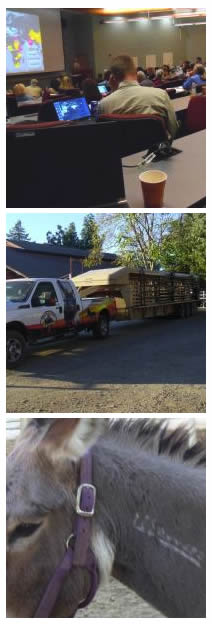 The sheer scale and size of the operation and the problems they face soon becomes apparent. The BLM looks after 32 million acres and in total they have about 40,600 equines, that’s 33,780, at the last count, of mustangs, and 6,825 wild Burros (donkeys), in addition to that the BLM cares for some 33,800 mustangs in long term facilities and pastures and has a further 15,143 animals in short term locations, the sheer scale of their enormous task becomes apparent, the difficulties of balancing the needs of the wild horses and donkeys, the range management, the use of all the different areas falling within the law, meeting the welfare standards of those animals in their care is an enormous task. There is no easy answer, the BLM often receives a great deal of criticism for its rounding up and removal of animals from the range, although there is always room to learn and improve. From the videos and pictures we see it is pretty clear that without their management thousands of animals would starve to death and the range that they live on would be destroyed for perhaps hundreds of years into the future, there are no easy answers.
The sheer scale and size of the operation and the problems they face soon becomes apparent. The BLM looks after 32 million acres and in total they have about 40,600 equines, that’s 33,780, at the last count, of mustangs, and 6,825 wild Burros (donkeys), in addition to that the BLM cares for some 33,800 mustangs in long term facilities and pastures and has a further 15,143 animals in short term locations, the sheer scale of their enormous task becomes apparent, the difficulties of balancing the needs of the wild horses and donkeys, the range management, the use of all the different areas falling within the law, meeting the welfare standards of those animals in their care is an enormous task. There is no easy answer, the BLM often receives a great deal of criticism for its rounding up and removal of animals from the range, although there is always room to learn and improve. From the videos and pictures we see it is pretty clear that without their management thousands of animals would starve to death and the range that they live on would be destroyed for perhaps hundreds of years into the future, there are no easy answers.
Like everything, it just puts the problems that we work with in donkeys and mules into perspective. The Donkey Sanctuary cares for around 4,500 donkeys and mules and currently manages to reach around a million donkeys with its work directly or through partnerships. Yet our new aim is to reach two million donkeys and mules, the enormous challenges facing organisations like The Donkey Sanctuary, the BLM and every small charity out there are only too apparent, you need facilities, money, time, good staff to be able to deliver on the care and welfare that is required by the animals that we all love so much.
It is pretty clear that only by working together with other organisations, by sharing our knowledge and experiences that we are going to be able to tackle the enormous challenges of donkey and mule welfare around the world; this is brilliantly summed up by David Cook, the CEO of The Donkey Sanctuary, as he makes a presentation to the symposium, starting with the wonderful video encapsulating Dr Svendsen's life and her legacy and going on to explain the sheer size and scale and demands that face the Sanctuary and the incredible achievements that occur every day that demonstrate what amazing work the Sanctuary does.
Following the video, there are quite a few tears and that happens again when David shows a video of some of the work of our donkey assisted therapy centres and the Romanian video of our partnership in Romania providing donkey assisted therapy facilities.
Actually, I am called away in the middle of all of this, Dr Eric Davis the driving force of this event in co-ordination with a great team, comes up and asks if I wouldn’t mind going over to the corrals again and maybe doing a little bit of work with the donkey with the feet problems from yesterday as his owners are coming to pick him and his friends up and maybe I could find a way to talk to them about the obesity in their donkeys.
It is always a daunting task to have to tell an owner that their donkey is fat and there are certain ways to do it but you can’t get away from the fact that a fat donkey is a welfare issue, there is nothing good about being a fat donkey and it is our responsibility to be able to try and control their weight.
You see, there are different welfare issues in different parts of the world, some donkeys may not be fed properly and become painfully thin through hard work or ill-fitting harness, many donkeys in the western world become obese, suffer from liver and kidney problems associated with being overweight, along with the increased risk of laminitis and arthritis, just because they do no work and are fed incorrectly, it is a massive welfare problem.
Bless him, I was able to go in and catch Joseph, and almost instantly he was letting me pick up all four feet like it had never been a problem, it is incredible the amount of trust these animals develop so quickly if you are consistent, patient and use some positive reinforcement. His owners turn up with a trailer to pick him up and we have a bit of a conversation, and it turns out that, unfortunately, these donkeys belong to a charity who have 80 horses and the donkeys are kept as pasture ornaments but in truth, the lady who is employed to look after them admits she doesn’t actually like donkeys and prefers horses, as does the handy man who helps her, but she recognises that they are overweight and she says she has tried but she has met resistance within the charity and this is an all too common problem of misunderstanding what true welfare is all about, so we chat about it and she agrees for me to send her all the information we have on obesity and training for picking up feet which they also say they don’t have time to continue.
It feels a little disheartening but of course that’s the nature of welfare work, you do everything you can, sometimes you win big, sometimes you don’t win at all and sometimes you just open a small window and you might never know whether you have made a difference in the long run but you have to rely on the possibility or you would give up and never do anything.
It has been a tremendous opportunity to come and work here for the first time for The Donkey Sanctuary, for us, as a team, to be able to display what we do from the work overseas to the work of our farms, the sheer scale of the things we have to organise, the donkey assisted therapy centres, the amount of fundraising, marketing, PR, just the incredible machinery that we are all part of at The Donkey Sanctuary that makes the work of helping donkeys possible.
I am not sure that many people had an idea of the true size of what we do and what’s fantastic looking at our new strategic plans for the next five years and beyond is that we are going to work more in collaboration with more organisations to offer support, help, to share our existing knowledge, and hope that we can reach those two million donkeys that are our target.
In truth, yet again, I have been humbled by the passion and enthusiasm of people who want to care for donkeys and mules and in the case of the BLM, horses too. The massive scale of the problem sometimes seems daunting but when you are in a room full of 130 people with the same aims, goals, ambitions, desires, you get a sense that something amazing is possible, that actually with continued co-operation, with renewed opportunities to work together and the continued support of the amazing Donkey Sanctuary supporters whose donations of money and time truly do make a difference on so many levels, that one day we will get there and we will reach all the donkeys that we need to and yet again I am indebted to The Donkey Sanctuary and its supporters for the opportunity to make a small difference to a few donkeys and to rely on that gently rippling effect of the work we do to spread out to make a massive difference to many more donkeys that we will never see or know about.
Thank you for taking the time to read these blogs and for your support of The Donkey Sanctuary.
Bye for now.


